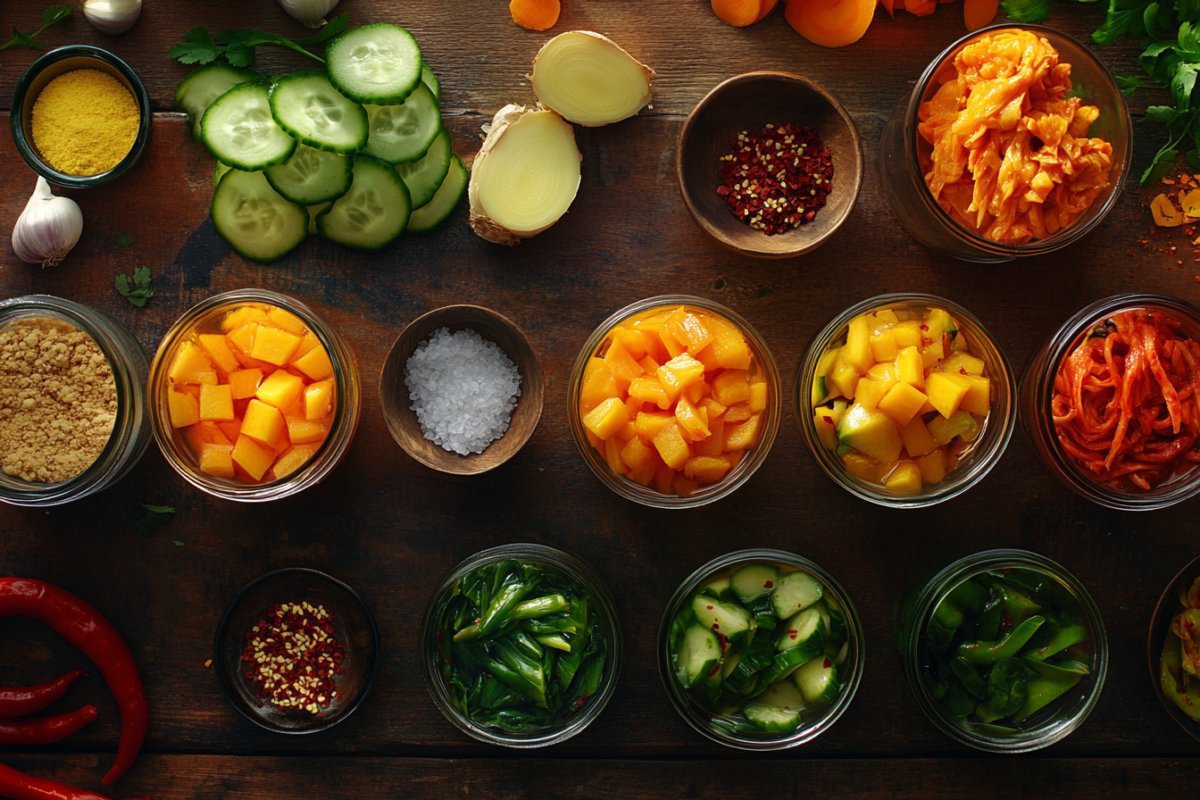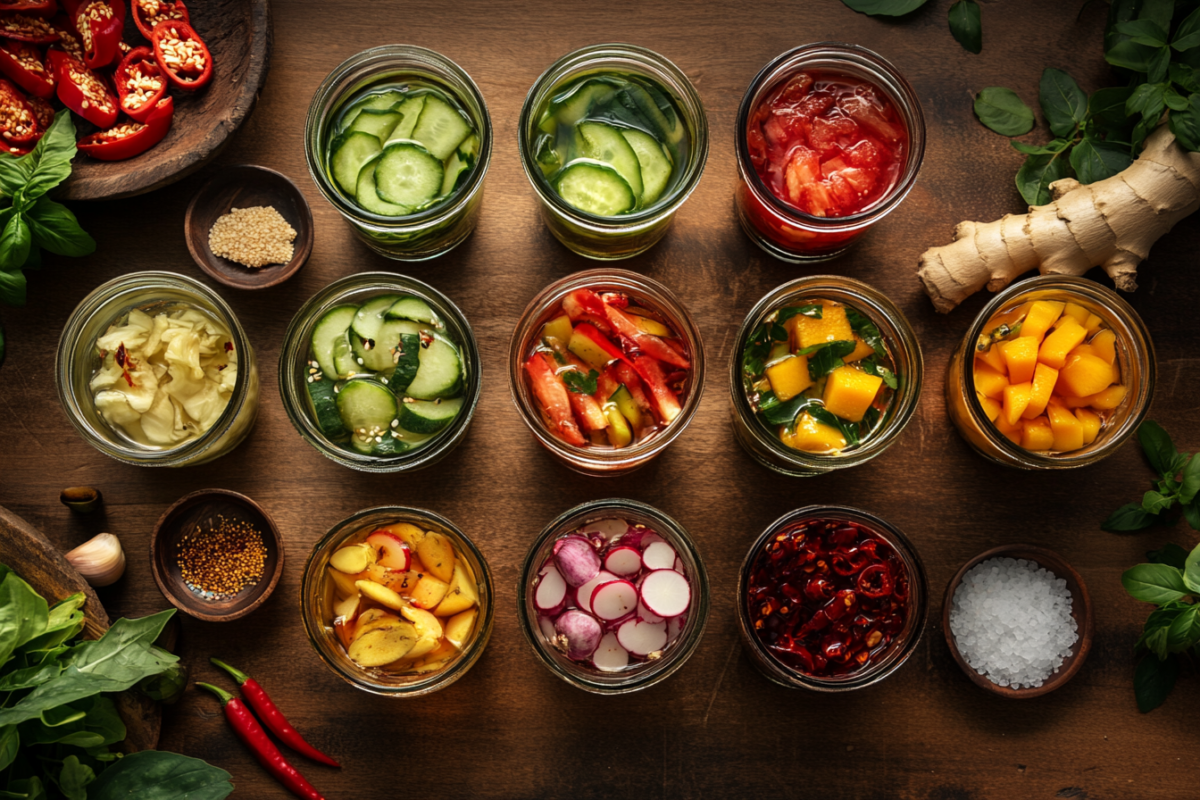If you’ve ever wondered how to make a delicious Asian pickle recipe, you’re in the right place! Asian pickles are a culinary treasure trove, offering a symphony of flavors that range from tangy and spicy to sweet and savory. Whether you’re craving the crunch of Japanese tsukemono, the fiery kick of Korean kimchi, or the bold tanginess of Indian achar, there’s an Asian pickle recipe for every palate. In this guide, we’ll walk you through everything you need to know to make these vibrant condiments at home, from essential tools to easy-to-follow instructions. Let’s dive in!
Introduction to Asian Pickle Recipes
Asian Pickle Recipe: A Fusion of Tradition and Flavor
Asian pickling isn’t just about preserving food; it’s an art form that has evolved across centuries. These pickles capture the essence of cultural diversity, showcasing the spices, techniques, and flavors unique to each region. For instance, the sour notes of Chinese pickled vegetables are a far cry from the sweet-spicy profile of Indian lime achar.
Why Are Asian Pickles So Popular?
- Burst of Flavor: Asian pickles are packed with robust flavors that complement a variety of dishes, from plain rice to rich curries.
- Health Benefits: Many Asian pickles are fermented, promoting gut health with probiotics and enhancing nutrient absorption.
- Cultural Connections: Making these pickles at home allows you to experience the culinary traditions of Asia, right in your kitchen.
Quick Fun Fact:
Did you know that Korean kimchi was traditionally buried underground to ferment during winter? This ancient technique ensured optimal temperature control, resulting in its distinctive flavor.
What Are Asian Pickles?
Understanding Asian Pickles
Asian pickles are not just about preserving vegetables; they’re an essential part of the cuisine across different cultures in Asia. Each region boasts its own unique approach to pickling, leading to a rich variety of flavors and textures that cater to diverse taste preferences. Whether it’s the tangy crunch of Japanese tsukemono or the fermented depth of Korean kimchi, Asian pickles bring a delightful complexity to any meal.
Types of Asian Pickles
- Quick Pickles (e.g., Japanese Tsukemono):
Quick pickles are made in a matter of hours, making them a great option for those in a rush. They involve a simple process of soaking vegetables, like cucumbers or radishes, in a mixture of salt, sugar, and vinegar. Tsukemono is one of Japan’s most iconic pickles, with a crisp and refreshing flavor, often served as a side dish with rice and fish. - Fermented Pickles (e.g., Korean Kimchi):
Fermented pickles, like Korean kimchi, are created through a process of lacto-fermentation. This method gives the pickles their distinctive sour taste and rich umami flavor. Fermented pickles often include ingredients like cabbage, garlic, chili flakes, and ginger, and they’re packed with probiotics, making them a great addition to your gut health. - Vinegar-Based Pickles (e.g., Chinese Pickled Vegetables):
Vinegar-based pickles, common in Chinese cuisine, are often quick and simple. They usually consist of vegetables such as carrots, cucumbers, and mushrooms, soaked in a vinegar solution with added seasonings like soy sauce and sugar. The result is a tangy, sweet, and savory pickle that adds a burst of flavor to any dish.
Popular Ingredients in Asian Pickles
- Vegetables: Common vegetables used in Asian pickles include radishes, cucumbers, carrots, ginger, and eggplant. These ingredients bring a crunchy texture and a refreshing bite that balances out the bold pickling flavors.
- Flavoring Agents: The magic of Asian pickles often lies in their seasoning. Ingredients like soy sauce, vinegar, ginger, garlic, chili flakes, and sesame oil bring complex layers of flavor. Each element adds its own twist, making Asian pickles a symphony of tastes. For example, soy sauce offers saltiness and depth, while ginger provides a spicy warmth.
Benefits of Making Asian Pickles at Home
Why Choose Homemade Asian Pickles?
Making Asian pickles at home isn’t just a fun, rewarding experience—it also comes with numerous benefits that store-bought versions simply can’t compete with. Here’s why you should consider picking up your pickling jars and getting started in your own kitchen.
- Health Benefits (Probiotics, Low Preservatives):
One of the greatest advantages of homemade pickles is their health benefits. Fermented Asian pickles, such as kimchi or tsukemono, are rich in probiotics, which promote a healthy gut and digestive system. Unlike many store-bought options, homemade pickles often contain fewer preservatives, making them a cleaner, more natural choice for anyone watching their intake of chemicals or artificial additives. Plus, the probiotics in fermented pickles may help improve nutrient absorption and boost your immune system. - Customizable Flavors and Ingredients:
Another benefit is the ability to tailor the flavors and ingredients to your liking. Whether you prefer your pickles to be extra spicy, subtly sweet, or tangy, you have complete control over the seasoning. Want more ginger in your kimchi? Or perhaps a dash of soy sauce to your Chinese pickled vegetables? You can experiment and adjust the recipe until you’ve created the perfect pickle for your taste buds. - Cost-Effective Compared to Store-Bought Options:
While store-bought Asian pickles might seem convenient, they can quickly add up. By making your own, you can save money while creating larger batches. Plus, you’ll avoid the hidden costs of added sugars, preservatives, and packaging. Making pickles at home allows you to control your spending and produce high-quality, homemade versions at a fraction of the cost.
Essential Tools and Ingredients

Preparing for Asian Pickle Recipes
Before diving into the exciting world of Asian pickle recipes, it’s essential to gather the right tools and ingredients. While the process may seem daunting at first, having everything prepared will make your pickling adventure smooth and enjoyable. Let’s take a closer look at the must-have items you’ll need to create these tangy, flavorful treats.
Tools You’ll Need
- Glass Jars:
Glass jars are a must for storing your pickles. They’re non-reactive, meaning they won’t interact with the brine or change the flavor of your pickles. Whether you’re making fermented kimchi or vinegar-based pickles, use airtight glass jars to keep your creations fresh and crisp. Choose jars of different sizes depending on how much you plan to make. - Mixing Bowls:
A good-sized mixing bowl is needed for prepping your vegetables and mixing in your brine. Whether you’re tossing cucumbers with salt or stirring the ingredients for your pickling solution, a large bowl will give you the space you need. Opt for glass or stainless steel to prevent any flavors from being absorbed by plastic. - Weights for Fermentation:
If you’re making fermented pickles, like kimchi or tsukemono, you’ll need weights to keep your vegetables submerged under the brine. This ensures the fermentation process works properly, preventing the growth of unwanted bacteria. You can purchase specific fermentation weights or use a clean, heavy object like a small plate to hold your ingredients down.
Must-Have Ingredients
- Fresh Vegetables:
Fresh, crisp vegetables are the star of any Asian pickle recipe. Popular choices include radishes, cucumbers, carrots, and cabbage. Choose the freshest veggies available to ensure your pickles have the perfect texture and flavor. Look for produce that’s firm and free from blemishes. - Base Liquids: Vinegar, Water:
Vinegar is the backbone of many Asian pickle recipes, especially those that require a quick pickle method. Depending on your desired flavor, you can use different types of vinegar, such as rice vinegar, apple cider vinegar, or white vinegar. Water is typically added to balance out the vinegar’s acidity, creating the perfect brine. - Flavor Enhancers: Salt, Sugar, Spices:
Salt is a critical ingredient for both quick and fermented pickles, helping to draw out moisture from the vegetables and create a brine. Sugar balances the sourness of vinegar and salt, while spices like ginger, chili flakes, garlic, and soy sauce elevate the flavor profile. These seasonings can vary greatly depending on the region—whether you’re making Indian achar or Chinese pickled vegetables.
How to Make an Asian Pickle Recipe
Step-by-Step Guide to Making Asian Pickles
Making your own Asian pickles at home is simpler than you might think! Whether you’re opting for the quick pickle method, diving into fermented pickles, or preparing a classic vinegar-based recipe, here’s a step-by-step guide to get you started.
Basic Pickling Method
- Cleaning and Preparing Vegetables:
Start by thoroughly washing your vegetables. This is essential for removing any dirt or pesticides. After cleaning, slice or chop your veggies into bite-sized pieces. Popular choices include cucumbers, carrots, and radishes. Depending on your recipe, you can choose to peel or leave the skin on. - Creating the Pickling Brine:
The brine is what gives your pickles their signature tang. To make it, combine vinegar (rice vinegar, white vinegar, or any vinegar of your choice) with water, and then add salt and sugar. Stir until the salt and sugar are completely dissolved. You can also enhance the brine with soy sauce, garlic, ginger, and spices like mustard seeds or chili flakes, depending on your preferred flavor profile. - Combining Ingredients and Storing:
Once the brine is ready, pack your cleaned and chopped vegetables into glass jars. Pour the brine over the vegetables, making sure they’re fully submerged. Close the jars tightly and keep them in a cool location. Depending on your recipe, you may want to let them sit for at least a few hours for quick pickles, or longer for a more intense flavor.
Fermented Pickles Recipe
- Preparing Ingredients for Fermentation:
If you’re making fermented pickles, such as kimchi or tsukemono, you’ll need to salt your vegetables first to draw out moisture. Slice your veggies (typically cabbage, radish, or cucumber), and then sprinkle salt over them. Allow them to rest for 30 minutes to an hour. The salt helps the vegetables release water and softens them, which is necessary for the fermentation process. - Maintaining Temperature and Conditions:
Once your vegetables have released some liquid, you’ll need to pack them tightly into a jar or fermentation vessel. Make sure the vegetables are submerged under their own brine to prevent spoilage. Store the jar in a cool, dark place (ideally around 65–70°F) for 3 to 7 days. During this time, the natural bacteria in the vegetables will ferment, giving you that signature sour flavor. Check the pickles every day to ensure they’re still submerged, and taste-test them to see when they’ve reached your desired level of tanginess.
Quick Pickle Recipe
- How to Make Pickles Ready to Eat in Just a Few Hours:
Quick pickles are the fastest way to enjoy Asian pickles without the long wait. After preparing your vegetables (sliced cucumbers, radishes, or carrots work best), prepare your brine with a mix of vinegar, water, salt, and sugar. Add in any additional flavorings like ginger or garlic to enhance the brine. Pour the brine over your vegetables, seal the jar, and let them sit at room temperature for a few hours. While the brine may not fully penetrate the veggies in this short time, they will absorb a delicious burst of flavor and be ready to eat within just a few hours!
Regional Variations in Asian Pickle Recipes
Exploring Pickles Across Asia
One of the most fascinating things about an Asian pickle recipe is the wide variety across different cultures. Each region has its own signature methods and flavors, offering a rich tapestry of tastes that range from tangy to spicy. Whether you’re in Japan, Korea, India, or China, you’ll encounter unique pickling techniques that reflect the history and flavor profiles of the local cuisine. Let’s explore the regional variations of Asian pickles and what makes each Asian pickle recipe so special.
Japanese Pickles (Tsukemono)
In Japan, tsukemono (literally “pickled things”) is an essential part of daily meals. These Asian pickles are typically made from vegetables such as cucumbers, radishes, and eggplant, preserved using vinegar, salt, or fermentation. A traditional Asian pickle recipe for tsukemono offers a delicate balance of sour, salty, and sometimes sweet flavors, which makes it a popular accompaniment to rice.
Korean Pickles (Kimchi, Danmuji)
Korean Asian pickles, particularly kimchi, are among the most famous globally. The classic kimchi recipe features napa cabbage and radishes, seasoned with garlic, ginger, chili flakes, and fish sauce. This spicy, fermented Asian pickle recipe is a cornerstone of Korean cuisine, served as a side dish with nearly every meal. Danmuji, another popular Korean Asian pickle recipe, is a bright yellow pickled radish that pairs perfectly with kimbap (Korean sushi rolls).
Indian Pickles (Achar)
In India, achar (Indian pickles) are often made from mangoes, limes, carrots, and chilies. What sets an Indian pickle recipe apart is its combination of spices—such as mustard seeds, fenugreek, turmeric, and asafoetida—that impart bold, spicy, and tangy flavors. These Asian pickles are often enjoyed with dal, rice, or naan.
Chinese Pickles (Suan Cai)
Chinese Asian pickles, such as suan cai, are typically made with napa cabbage or mustard greens. This Chinese pickle recipe involves pickling with salt and fermentation, creating a slightly sour flavor. Suan cai is popular in northern China, where it pairs wonderfully with savory meals and adds a tangy crunch to stir-fries and soups.
Serving suggestions and pairings for this Asian Pickle Recipe
How to Enjoy Asian Pickles
- Pair with Rice or Noodles:
An Asian pickle recipe is a perfect side dish to pair with steamed rice or stir-fried noodles. The bold flavors of the pickles contrast with the neutral taste of rice and add a zesty punch to your noodles. - Use as a Condiment for Main Dishes:
Whether you’re preparing a hearty bowl of ramen or a sizzling stir-fry, an Asian pickle recipe can elevate the dish. A spoonful of kimchi or tsukemono can add an extra layer of flavor to any meal. - Serve as a Side Dish with Grilled Meats or Tofu:
The acidity and spice of an Asian pickle recipe make them the perfect complement to grilled meats, tofu, or other vegetarian dishes. They help cut through the richness of grilled foods and bring a delightful crunch to your plate.
Storage and Shelf Life of Asian Pickles
<strong>Keeping Your Pickles Fresh
Proper storage is key to preserving the flavor and texture of your Asian pickles. Here are some essential tips for keeping your Asian pickle recipes fresh:
- Proper Storage Conditions (Temperature, Container):
Store your Asian pickles in airtight glass jars and place them in a cool, dark area. For fermented Asian pickles, such as kimchi, keep them at a consistent, cool temperature to ensure the fermentation process continues properly. Quick pickles can be refrigerated to slow down further fermentation. - How to Tell if Pickles Have Gone Bad:
If your Asian pickles develop an off smell, mold, or an unusual color, it may be a sign they’ve gone bad. Fermented Asian pickles should have a tangy aroma, but any sour or rotten smell indicates spoilage. - Tips for Extending Shelf Life:
To extend the shelf life of your Asian pickles, always store them in sealed containers and ensure they remain submerged in brine. Regularly check the brine level and top it off if needed. With proper care, many Asian pickle recipes can last for several weeks in the fridge.
Frequently Asked Questions
How long do Asian pickles recipe take to ferment?
Fermentation time varies by recipe. For example, a kimchi recipe typically takes 3 to 7 days to ferment properly, while other types of Asian pickles may take a bit longer. You can taste-test your pickles along the way to see when they reach the desired tanginess.
Can I use any vegetables for Asian pickles recipe?
While traditional Asian pickle recipes use specific vegetables like cucumbers, radishes, and cabbage, you can experiment with other vegetables as well. Just make sure the vegetables you use can hold up to the pickling process without becoming too mushy.
Are Asian pickles recipe healthy?
Yes! Many Asian pickles, especially fermented varieties like kimchi or tsukemono, are rich in probiotics that support digestive health. However, be cautious of the salt content, as pickles can sometimes be high in sodium.
What’s the difference between quick pickling and fermentation?
Quick pickling involves soaking vegetables in a vinegar-based brine for just a few hours to a day, whereas fermentation uses natural bacteria to develop the flavor over several days. Fermented Asian pickles tend to have a more complex, tangy flavor.
Can I reuse the brine for another batch for Asian pickle recipe?
It’s possible to reuse the brine for a second batch of Asian pickles, particularly for quick pickles. However, for fermented pickles like kimchi, it’s best to avoid reusing the brine to prevent contamination.

